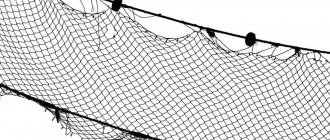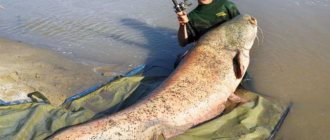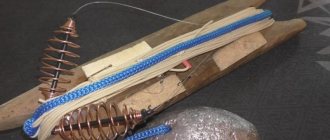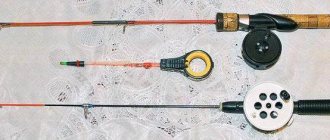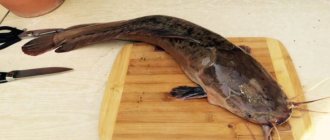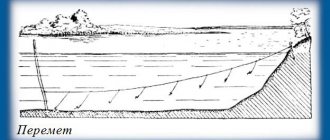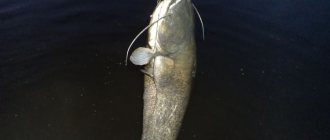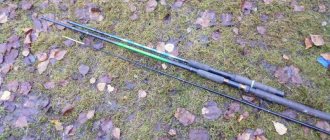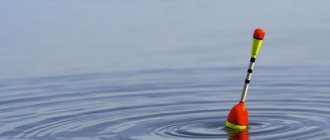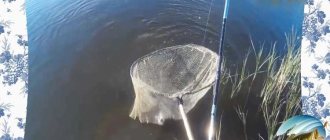Fishermen, especially of new generations, no longer know what a line is, although this gear has been used for catching catfish for quite a long time. As in any other direction of fishing, there are a lot of details, without which the chances of success are close to zero. In this article, we will reveal all the intricacies of catching catfish using nets, talk about what the correct assembly of gear is, what its installation should be like on a reservoir, what means should be used to attract it, and how to shave the spots.
How the tackle is assembled and its types
The line is a piece of very strong fishing line to which leashes with hooks are tied. There are two types of “stretch marks”: bottom and surface. The name of the first lines speaks for itself; the fisherman places them on the bottom. Bottom slings are equipped with weights that allow you to sink the tackle and large floats that serve as alarms and means for pulling. There are also subspecies. It is permissible to call them any hybrid of the first and second species.
Anglers usually place surface streamers on not very wide rivers, from bank to bank. Such a transfer can also be made from the bottom type by shortening the cords leading to the floats.
A perch designed for large catfish. In this option, the live bait is attached separately from the other hooks. The photo shows the process of checking the gear
IMPORTANT! This gear is considered poaching in many reservoirs. Before fishing, try to find out in as much detail as possible whether a net can be used here, when and how many hooks are allowed.
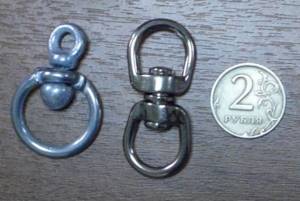
Swivels reduce the stealth of the gear, but eliminate twisting. For large fish, massive equipment is used
To create it we need a strong nylon cord. For trophy catfish (they can be 300 kilograms, 5 meters in length) we go with a net made of rope, and the hooks are comparable in size to the palm of an adult. In standard situations, they use a nylon cord of about 25–30 meters, hooks of 10–15 numbers by domestic standards and a leader line 1 millimeter thick. When hunting a large specimen, 3–4 mm leashes are also used.
You can use anything as a sinker: bricks, small metal anchors, stones and the like. Floats (if needed) are pieces of foam plastic, dimensions are approximately 30 by 30, and 5-8 centimeters thick.
IMPORTANT! Fishing from the shore is safer in terms of losing gear due to the bite of large fish. Large catfish are always caught on the line with a diverter cord, which is subsequently fixed on the shore (you can tie it to the nearest tree).
What is a shift?
The most productive gear, which is designed specifically for catching deep-sea fish, is called a reel. With its help, they catch both predatory inhabitants of rivers and peaceful fish. The catfish saddle looks like an elastic band, but the elastic itself is not used in its structure.
The design of the net is quite simple and practical, thanks to which it is used for catching fish in weak, shallow places where there is not a lot of debris. The main advantage of the design is secrecy; it is almost impossible to notice a correctly installed device.
What is needed for production?
A standard pass consists of the following elements:
- thick twine;
- leashes;
- large hooks.
Since twine is the backbone of fishing gear, it must be thick enough to support the load of the catch. In the absence of this element, the use of ordinary thick rope is allowed. The length of the string is often about one hundred meters.
Leashes with a length of 40 centimeters are attached to the base. They are placed evenly, leaving an interval of approximately 2 meters. A large metal hook is attached to each leash. If you plan to catch catfish, pay special attention to the quality of the hook. This piece of gear must be strong enough to hold large fish.
Article on the topic: Catfish bait
Installation methods
Here, as everywhere else, the fisherman not only wants to increase the efficiency of the gear, but also has to adjust a lot of different conditions. In addition, the nature of modernization also depends on its origin. For example, Siberian fishermen fish with their own variants, but catfish catchers, say, on the Volga, may have completely different patterns.
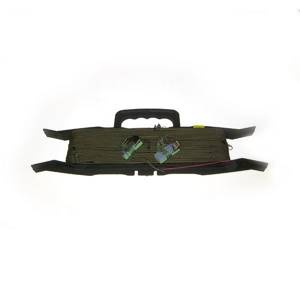
In fishing stores you can also find ready-made, assembled gear. This, for example, model is designed for 50 meters, the thread is already selected for green water
Mostly, boats are used when installing fenders, especially on large bodies of water. For small rivers and lakes, fishermen invented a different version, structurally similar to an ordinary zakidushka. Everything is the same: a board with cutouts for the cord, the fishing line itself with leashes, hooks, sinkers and floats. Similar application:
- The tackle is carefully unwound and the fishing line is folded next to it.
- Lures are put on hooks.
- The fisherman swings the line and launches it into the water.
- The cord with hooks goes to the bottom, not reaching the surface. The floats prevent you from sinking further.
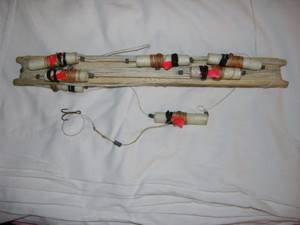
Homemade compact version. You can hang tees. Increases the chance of successful lip hooking
Such a line quickly prepares for fishing, it is easy to double-check (pulled it out and threw it again). Resourceful and inventive fishermen did not stop at creating a casting net as such.

A very interesting element has been updated in the equipment - a reel float, which allows you to adjust the depth of the hooks, and for each of them it can be configured differently.
There are several options for installing the crossbar. The most common is float mounting. There are also arc and angular ones, and almost every option can be adjusted to both shore and boat fishing.
IMPORTANT! Experienced fishermen do not recommend placing hooks completely on the bottom. They must be at least slightly raised above its surface.
Corner installation is the installation of crossbars in such a way that there is an angle relative to the two halves. It can be formed at the bottom or on the surface of the water. The bottom corner is done like this:
- A cord is fixed on one side.
- The fisherman delivers half of the gear to the loading point. He attaches the sinker and throws it.
- The second half is fixed on the other side so that the sinker remains at the bottom - the tension is adjusted.
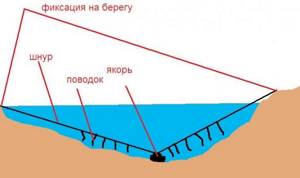
Reliable fixation will be required on both sides. Try to disguise the places where the cords are attached so that no one else can pull out the tackle
The reverse angle is more suitable not for shore fishing, but for boat fishing:
- An anchor with a cord and hooks is thrown into one hole.
- The fisherman swims out and sets the float about halfway through the thread.
- Swims to the second hole and throws an anchor there with the other half of the gear.
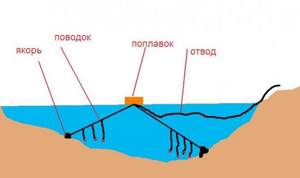
Both methods have advantages and disadvantages. The first case is good if you have the opportunity to use both banks, and such a crossing will not be affected by a motor boat, for example
The latter option is convenient if the pits where catfish live are located far from the banks, and both halves of the cord with hooks can be directed into different recesses. It is still advisable to do a diversion to the shore, if possible.
Arc installation involves a smooth transition of the cord from shallow to deep areas, or vice versa. To make the arc go downwards, you will need sinkers, and upwards - pieces of foam. Look at the diagram:

The stronger the river current, the more weights we will need so that all the tackle does not rise, and the leashes (they can be equipped with pellets) do not float away, otherwise the whole point will be lost
Some installation options involve submerging the fisherman himself. Anchors with special rods are mounted directly on the bottom, and the tackle is placed between them, like a guy wire. A diversion is made from it to the shore. In this case, special equipment will be required, and at very great depths it is very problematic to perform such actions.
IMPORTANT! As the main connection of cords and leads with bends, you can safely use a simple and reliable figure-of-eight knot. It is easy to assemble and disassemble.
There are also one-way floatless straps. In principle, they are no different from ordinary hooks - a base (rotating reel), a thick cord with leashes and hooks, and a weight. The appropriate gear is always set up in the evening and checked in the morning, so you must try to secure such spears very securely so that they are not dragged away by the catfish.
How to do it yourself?
All fishermen dream of catching a giant freshwater fish - catfish. And the line is one of the most effective ways to catch this fish. You can make such tackle yourself, because it is quite simple to do, you just need a little time, effort and materials.
You can, of course, buy such gear, but it will cost much more than making it yourself. Therefore, in this article you will find detailed instructions on how to make a catfish transfer yourself.
Required materials and tools
The sewing device is very simple, and it won’t be difficult to make. The work itself will not take much time and effort. The cost of materials is very small, but the catch using it is huge.
So, in order to make a catfish trap with your own hands, you need the following materials:
- Nylon cord, but you can also use thick fishing line or rope.
- Leash, length should be approximately 30-40 centimeters.
- Single hooks. Numbers four or five.
- Auxiliary cargo. About 200-250 grams.
Step-by-step manufacturing instructions
It is very easy to make a crossbar yourself, because its design is simple and does not contain complex machinations.
So, these instructions will help during the manufacture of this gear:
- Since catfish is a fairly large fish, the length of the line should be approximately 75 meters, the diameter of the rope should be at least thirty millimeters. First you need to tie the leashes to the rope itself, which will make up the leash.
- Leashes need to be tied every meter and a half. You can attach them using carabiners or special fasteners. The length of the leash itself is from thirty centimeters. Optimal 35-40. This length will prevent the leashes from getting tangled.
- If there are no hooks, then you can use ordinary nails, which are pre-bent and hardened. Their length should be 15 centimeters.
- Once the leaders are attached to the rope, you can begin attaching the hooks. They are attached like a regular fishing rod, there is nothing complicated. The main thing is to attach it firmly.
- You need to attach a weight to the ends of the leash so that the strap does not float up and is not carried away by the current.
- It must be installed across the river and secured at some distance from the bottom.
Lures
How to assemble donka for catfish with your own hands (diagram)
These fish are often called scavengers; many fishermen have a stereotype: they must be caught with something rotten. Yes, they willingly consume rotten animal meat, but their diet is not limited to this. Experienced fishermen consider the green frog to be the most important delicacy.
There are other baits:
- leech. These worms are readily consumed by catfish;
- poultry offal. Those who have the opportunity, when cutting a bird, set aside unnecessary entrails, such as intestines, stomach, and the like;
- small fish. Yes, catfish often practice predation. They like small crucian carp, tench, roach, bleak or burbot;
- bear This insect lives in vegetable gardens, although they can often be found on sandy shores. If you notice such bumps in the sand as a passage, a mole cricket has done this;
- mud and earthworms. For a large inhabitant it is better to use the first type. Mud worms (they have a long, massive body) live near overgrown rivers or lakes, in soft soil where reeds, cattails or arrowheads grow;
- fried bird. These could be pieces of cooked chicken, crow, or the body of a sparrow, for example. Wild birds can be caught in a special trap or shot with an air rifle;
- crayfish;
- locusts, preferably larger ones;
- mice. If you have these rodents and you place mousetraps on them, we do not throw away the prey, but save it.
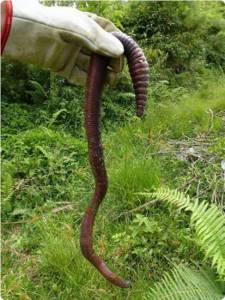
This is what a mud worm looks like. It can be hooked onto a very large hook! These particular specimens are rare, usually a little less
IMPORTANT! The basic rule is that the bait should sit as firmly as possible on the hook, because the fisherman checks the line after a whole night. They should last until the morning. And one more rule: try to get leeches, crayfish, frogs, mud worms and fish from the same reservoir. Local residents are more familiar with “their” food.
Habitat
He does not like to migrate and lives in his favorite places for a long time. Catfish are found in almost all fresh water bodies and lakes. The preferred habitat for this fish is rivers.
The mustachioed predator likes cool water, so it usually hides in the lower part of the reservoir, closer to the bottom. There the cunning man arranges peculiar hiding places and shelters. The fish hunts mainly at night. In spring or during the flood period, it is possible to see surface-swimming catfish.
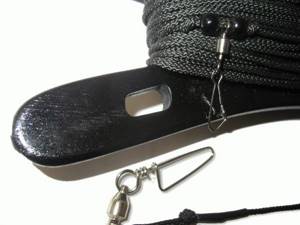
Also, the predator likes to make its home under bridges or dense vegetation above the water. In such places, he can hunt during the day, hiding under the shadow of structures. Among coastal inhabitants, it can hunt frogs, crayfish, insects, and chicks.
We suggest you read: Fishing for pike with a spinning rod in spring and autumn
Do I need bait?
Almost no one mentions the use of groundbaits when catching catfish using skeins. Yes, the bait mixture will not hurt us, but the situation is a little unusual. We have listed the main baits for these fish. What prevents us from using the same thing as bait? We will need a gauze bag, you can use a string bag. We put a sinker at the very bottom of the feeder, throw in offal, fried meat, for example. We close the bag and fix it somewhere on the strap. The same can be done with anchors. Additional means of attraction, using baits that catfish love, will only increase the chances of catching a trophy.
Features of installing a saddle from a boat
Preparing gear for this method of catching catfish is no different from the previous ones. The only difference is in the way they are installed. Moreover, the entire process can be performed either independently or with an assistant. Three options are most commonly used.
The first requires the presence of an assistant. At the same time, this transfer to catfish does not have any difficulties in terms of how to do it. In it, as in all the others, leashes are tied to the main fishing line, and bait is attached to the hooks. It is then carefully rolled up and placed in a bucket. It is most convenient to install gear from a boat with an assistant. In this case, one angler untangles and installs the line, and the second at this time controls the floating device. This fishing method is usually used if you need to quickly set up several gears.
The second option is used when there is only one fisherman on the boat. In this case, in order to avoid tangling the gear, you can first secure the main fishing line, and then install it: weights, floats, hooks with bait, gradually moving from one end to the other.
The third option assumes that one angler is on the shore, and the second, taking one end of the tackle, floats on the boat, gradually unwinding it. After the tackle is completely untwisted, its edges are secured and they begin to tie the leashes and attach the bait.
Selecting a location
Catfish live at depth, in the pits of rivers and lakes. These could be places near cliffs, pools or areas under bridges. They can also swim on the spit and rifts. At night, catfish migrate and approach the shore, but they still try not to stray far from their holes. In extreme heat, they do not come out of the recesses at all.
Bottom nets cannot be placed where the bottom is littered with debris or snags - there is a high probability of losing gear. This type requires a clean bottom surface. You can find out where there are deep holes near the reservoir (if you don’t know this) using a marker weight or an echo sounder. The easiest way is to ask experienced fishermen who have been coming here to fish for many years.
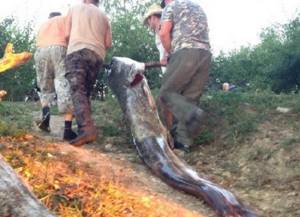
Often fishermen catch real giants using a whole fried chicken!
Catching for catfish by casting begins in April. Until the beginning of summer they have a strong hunger. They eat everything. Then the appetite subsides from July to early autumn, and with the onset of cold weather, catfish fishing stops. Fish lose activity and prepare for hibernation.
What time to catch the line
In fact, the place for catching catfish with slings doesn’t really matter. The thing is that catfish are nocturnal fish, and at night they swim out from their place to feed; they can swim anywhere. Therefore, you can successfully catch catfish using nets at night either in a deep hole, spit or riffle.

Mole cricket bait.

Bream on the rocker in winter.

Catching chub on a donk, choosing a place for fishing and fishing equipment
Predatory fish like pike perch, catfish and pike hunt around the clock. However, on hot days their activity decreases noticeably. It is advisable to load the net with fresh live bait at night, and check and change the bait early in the morning. If the place and depth of immersion for the hooks are chosen correctly, then the catch can turn out to be solid, and the fish soup fatty and rich.
You can catch catfish using a line at any time of the year. But in winter only when the reservoir is not covered with ice. After all, the presence of such an obstacle makes fishing with a line impossible.
There is no specific fishing spot for catfish; any hole, spit or riffle is suitable. After all, catfish can swim anywhere, as they swim out at night in search of food.
You can set a line both in rivers and on lakes. For each type of reservoir there is a different installation method. For rivers you need to place it in the middle of the current, and in closed reservoirs - not far from the shore, where the fish are often fed.
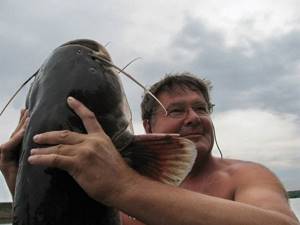
You need to carefully choose the installation location, because if there are snags at the bottom, the net may get caught, and this will lead to loss of gear.
For bait, you can use live bait, such as crucian carp, burbot, bindweed or other types of fish that have high endurance. You can also use chicken or fish offal. A fish like catfish will not refuse frogs (especially river ones), crayfish or red worms.
Catfish are often caught using leeches or mole crickets, because they stay on the hook for a very long time.
- You should never skimp on the quality of your gear, because if it is made correctly, it will last for many years.
- When you need to swim to check the tackle, be sure to take a landing net with you.
- When you come across very large specimens, it is best to wait a while until the fish gets tired, and then place it in a net.
- To make the leashes more reliable, it is better to make them from rawhide.
- You need to install the crossbar very carefully and mask it very carefully. This is necessary so that in the morning you don’t have to be upset if the tackle is lost.
A group of fishermen revealed the name of the secret bait during interrogation.
Category: Regional news,
40 kg of fish for bait with pheromones. Report 2021!
The catchable bait ingredient will be banned from sale.
Illegal copying of materials from our site without mentioning the source link is prohibited.
, . Detained poachers told the secret of catching 318 kg of fish. Fishing inspectors were surprised by the absence of prohibited equipment.
Fishing in Three Rivers in summer: Akhtuba carp for cake (makukha) - Fishing on Akhtuba with comfort - fish...Fishing in Three Rivers...
Feeder equipment for catching carp, crucian carp, breamFeeder equipment…
We learn to fish with wobblers and choose the best models. Fishing with wobblers...
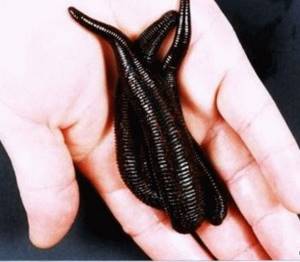
Floats for carp fishing: the right float tackle for beautiful carp The correct float…
A boat for delivering bait with your own hands and prices for purchased boats A boat for...
An article about drop-shot spinning equipment, installation methods, baits used, wiring - portal...Fishing. Inform...
Fishing with a Croatian egg, or a glider bait in practiceCatching a predatory fish…
How to choose a fishing echo sounder: tips for anglers How to choose fish...
Wobblers for pike perch: features of choice and 10 bestThe best wobblers ...
What is a shock leader for a feeder? Photo: how to make a shock leader for a feeder? How to make a shock...
Delivery of bait to the fishing zone - three options for homemade devices - Homemade products for fishing with your own ... Three options for sa...
Echo finders Humminbird - Lowrance - Raymarine (Page 1) - Boats, motors, accessories - Voronezh fish...News To about...
Catching crayfish with crayfish: fishing techniques, types of crayfish. Catching crayfish with crayfish...
Shock leader for carp fishing, what is itShock leader Karpf...
What kind of braid is used for shock leader Preservation of the base...
Video of low-power motors for boats: the whole truth about electric motors for fishing and more. The whole truth about...
We catch chub with a spinning rod, we go with a spinning rod for a nimble chub, we go with...
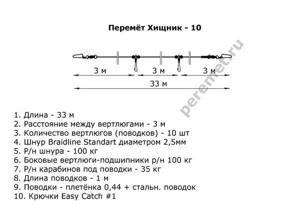
Do-it-yourself glowing bite alarm for night fishing - how not to get confused when choosing a signal... How not to get confused...
Bombarda - equipment and step-by-step instructions for tying equipment Fishing equipment...
Simple Drop-Shot - catchy equipmentSimple Drop-Sho...
Fishing with a sliding floatFishing with a sliding...
Catching roach with a float rod: in spring, summer and autumn Catching roach with…
How to properly equip a fishing rod: equipping a float rod, video How to properly…
How to properly equip a float fishing rod - diagrams and video instructions Correct equipment...
Multiplier reel: who needs it and how to choose the right oneChoosing the optimal...
Bombard rig - fishing methods, types of bombards, selection tips and fishing secrets. The best ways...
With a bombard for fryAn exciting r...
A float with a feeder as a new direction in fishing. Why do you need...
